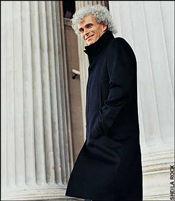At its première a critic heard
only “a tune for Dorothy Lamour in a sarong, a dance for Hindu
hillbillies”. At this Prom, Simon Rattle and the Berlin Philharmonic
proved conclusively how inventive it really is.
Rattle paired the Prelude from Tristan und Isolde with
the Liebestod. Often that’s a risk as it can leave you longing
for the singing, but Rattle had thought the two parts through in orchestral
terms. He makes a case for hearing the opera as "music", on its own terms.
Here, the surging waves of sound "are" the message, not background. He shows
how fundamental the flute part is, weaving throughout, commenting without
words. The transition was particularly well blended, one part fading
gradually into the next, like a fade in film gradually coming back into full
color focus. It is cinematic – how Wagner might have loved the movies
!
Wagner is an appropriate curtain raiser for Messiaen's
Turangâlìla. As a young boy, Messiaen studied Pelléas et
Mélisande, and also inherited the long standing French fascination for
the exotic and "oriental" - think Pierre Loti, Ravel, Maurice Delage and the
Impressionists studying Japanese painting. Wagner was by no means the
dominant influence on Messiaen, but his oceans swells and undercurrents live
on in Turângalìla, as Rattle so clearly demonstrated, stretching the
string lines with soaring, surging magnificence. Messiaen's "trajectory", to
use a favorite Boulez expression, comes not from conventional symphonic
development but from thematic ideas, so this oceanic surge is important.
For the first time, I really understood the sixth section, Le Jardin
du sommeil d'amour. It's slow, almost a relief after the hectic,
inventive fifth section, and has its longueurs. But maybe that's what
Messiaen was getting at. The lovers are together when they're asleep, in
dreams, when the moon pulls the tides that create the waves in the ocean.
It's not as spectacular as the glorious Joie du Sang des étoiles,
but as with so much Messiaen. he's at his most profound when he’s
quiet.
The Tristan und Isolde concept had even more personal meaning for
Messiaen. He had fallen in love with Yvonne Loriod, but he was married, and,
as devout Catholics, they could not marry until released by his wife’s
death. He "was" Tristan and she Isolde, and Turângalìla is their
mystical union. Hence the significance of the “paganism” in
Turângalìla. Messiaen was fascinated by non-western music, adopting
ideas such as the Indian deçi-tâla rhythms which feature in this piece.
Anyone who’s seen Hindu erotic sculptures can appreciate the concept of
sex as a form of spiritual enhancement, that breaks past the restraint of
western moral convention. So Turângalìla isn’t meant to be
polite “Good Taste”. Those sassy brass passages and almost
Gershwin-like punchiness are essential keys to the spirit of the work. The
famous "statue" theme on brass and clarinet "Flower" themes are "male" and
"female". No wonder Rattle placed such emphasis on how they intertwine,
flirting with each other, so to speak. Pierre-Laurent Aimard's piano and
Tristan Murail's ondes Martenot form a second pair of relationships within
the whole, connecting to percussion and winds, picked up by harp and strings.
Aimard's long solo passages are the unspoken "heart", rather like the flute
in Tristan und Isolde.
The Berlin Philharmonic played with extraordinarily beautiful, transparent
textures – how the brass fanfares shone ! This orchestra can be relied
upon for superlative orchestral color, so what was even more impressive was
how the Berliners took to Messiaen, whose music is so very different to their
mainstream core repertoire. Somehow Rattle inspired them so they played with
free spirited exuberance, capturing the exhilarating intoxication so crucial
to this composer’s idiom. The “bad taste” of
Turângalìla may shock, but it’s the exaltation of spirit that
connects mortals to the divine.
Turângalìla was commissioned by Serge Koussevitsky and premiered
by Leonard Bernstein who hated the piece and refused ever to conduct it
again. Perhaps it’s fortunate as he probably didn’t understand
its internal architecture. Nagano and Salonen have a firm grasp of the
energetic muscularity that animates the piece, but Rattle and the Berlin
Philarmonic exceeded all expectations, marrying technical perfection to
electrifying verve. This performance truly expressed how original and radical
Messiaen really can be.
Anne Ozorio
